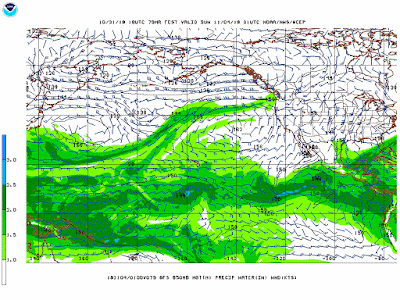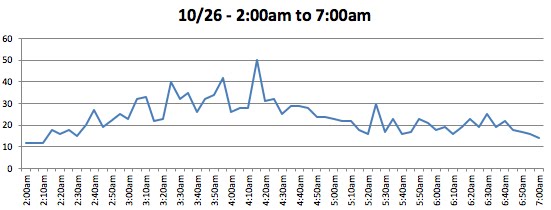But our friends on the western sides of the Olympics and Cascades will not be as lucky with substantial rain expected.
During the past several days, the winds aloft have been westerly (from the west), so we have been in the rainshadow of the Olympics, even though a strong, moist flow has approached the region.
During the past 72 hrs, while Tacoma to Everett has only gotten around .10 inches, locations on the western slopes of the Cascades have "enjoyed" 2-4 inches of rain, with 1-2 inches on the western side of the coastal mountains.
But this is just a "warm up" for this week. Early Friday morning a modest atmospheric river comes in from the southwest (the figure shows the forecast moisture in a vertical column).
Another on Saturday from a more westerly direction:
And even more on Monday.
The predicted total for the next 7 days, shown below, is impressive, with 5-10 inches in and to the immediate of the mountain crests. But if you look very closely, there is far less downstream of the Olympics--that is the rainshadow.
If you really want to impress your friends, tell them that some of the moisture hitting us Saturday will be streaming across the entire north Pacific, as shown by the following plot of moisture at roughly 5000 ft above sea level for Saturday at 6 PM.
_________________________________________
Initiative 1631: Bad for the environment and for Washington State
I-1631 is poorly written, will do little to reduce greenhouse gas levels in the atmosphere, gives control of billions of dollars to an unelected board, is regressive, so it hurts low-income folks the most, has no concrete plan for spending vast sums of money, is highly partisan, and is odds with our basic democratic principles. I have written three blogs describing its problems:
https://cliffmass.blogspot.com/2018/10/initiative-i-1631-at-odds-with.html
https://cliffmass.blogspot.com/2018/10/if-worry-about-climate-change-and-care.html
https://cliffmass.blogspot.com/2018/04/the-carbon-fee-initiative-1631-has.html
The pro-side has been highly deceptive, saying things that are demonstrably not true. Their mailers are telling folks that big polluters and oil companies will pay: this is a total falsehood. Everyone will pay.
Avista Utilities, which covers the eastern third of Washington State, yesterday released the numbers of how utility costs would increase under 1631 (see below). Roughly $ 400. per year in the fifteenth year. Amazingly, the Yes campaign denies this.
If you want to find out how much 1631 will cost you, check out this handy app. For most working adults, the 1631 fee will run between 150 and 300 dollars the first year (depending on your transportation choices, living arrangements, etc.).
The Yes side suggests that the initiative will have a significant impact on greenhouse warming. Simply not true. Let's assume that the initiative produces the promised reductions in emissions (down by 20 million metric tons in 2035 and by at least 50 million metric tons by 2050). If one plugs this into a climate model, one gets a global cooling of about .0001 degree C. Washington represents a very, very small part of global emissions and we are already quite green.
Today, the Yes on 1631 side has gone even further in its false stories. They accused the No folks of adding names to their endorsement list without permission. This has gotten a lot of press....but is inconsistent with the facts. The No side has SIGNED endorsement sheets from everyone noted as endorsing (and these signed endorsement sheets were shared with the Seattle Times).
And with all the tall tales provided by the YES on 1631 side, their advertisements accuse the No side of lying.
Truth and ethics matter. It is ironic that the Yes side is following the approaches of the President they despise, with false stories, inaccurate information, wild claims, and name calling become stock and trade of the Yes on 1631 side.
There is a religious fervor by some 1631 supporters to do something RIGHT NOW or the world will end. The truth is the best science does NOT suggest a sudden tipping point, and doing something of little value is both wasteful and prevents more effective actions. American's has rushed into "doing something" without a real plan and it has gotten us into trouble before (e.g., Iraq, Vietnam). 1631 would be a similar error, but for our state.
Global warming is too serious and the impact on our state too significant to throw away our ability to do something meaningful. 1631 is hyperpartisan, hardwired to a support a certain agenda, and will not work in a meaningful way to reduce our fires, prepare the region for climate change, or reduce our greenhouse gas emissions.




















































